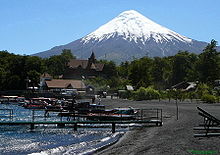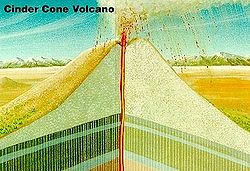- Volcanic cone
-
Volcanic cones are among the simplest volcanic formations. They are built by ejecta from a volcanic vent, piling up around the vent in the shape of a cone with a central crater. Volcanic cones are of different types, depending upon the nature and size of the fragments ejected during the eruption. Types typically differentiated are spatter cones, ash cones, tuff cones, and cinder cones.
Contents
Stratocone
Main article: Stratovolcano Osorno volcano in Chile is an example of a well-developed stratocone.
Osorno volcano in Chile is an example of a well-developed stratocone.
Stratocones are large cylindrical structures built up around a main tubular volcanic vent by more than one eruption. Stratocones can form large mountains and possess a distinctive layering of lava flows and tephra.
Spatter cone
A spatter cone is formed of molten lava ejected from a vent somewhat like taffy. Expanding gases in the lava fountains tear the liquid rock into irregular gobs that fall back to earth, forming a heap around the vent. The still partly liquid rock splashes down and over the sides of the developing mound is called spatter. Because spatter is not fully solid when it lands, the individual deposits are very irregular in shape and weld together as they cool, and in this way particularly differ from cinder and ash. Spatter cones are typical of volcanoes with highly fluid magma, such as those found in the Hawaiian Islands. The spatter that builds up the cone can either be agglutinated or welded, the former meaning that the individual spatters pose one above each other with a lesser degree of welding occurring, while welded spatter is almost fluid when it lands and therefore welds easily.
Ash and tuff cones
See also: Phreatomagmatic eruptionAn ash cone is composed of particles of silt to sand size. Explosive eruptions from a vent where the magma is interacting with groundwater or the sea (as in an eruption off the coast) produce steam and are called phreatic. The interaction between the magma, expanding steam, and volcanic gases results in the ejection of mostly small particles called ash. Fallen ash has the consistency of flour. The unconsolidated ash forms an ash cone which becomes a tuff cone or tuff ring once the ash consolidates (see also tuff). Flat-floored craters that scientists interpret have formed above diatremes as a result of a violent expansion of magmatic gas or steam; deep erosion of a maar presumably would expose a diatreme.
An example of a tuff cone is Diamond Head at Waikīkī in Hawaiʻi.
Cinder cone
Main article: Cinder coneA cinder cone is a volcanic cone built almost entirely of loose volcanic fragments called cinders (pumice, pyroclastics, or tephra). They are built from particles and blobs of congealed lava ejected from a single vent. As the gas-charged lava is blown violently into the air, it breaks into small fragments that solidify and fall as cinders around the vent to form a circular or oval cone. Most cinder cones have a bowl-shaped crater at the summit.
Cinder cones rarely rise more than 300 to 750 m or so above their surroundings, and, being unconsolidated, tend to erode rapidly unless further eruptions occur. Cinder cones are numerous in western North America as well as throughout other volcanic terrains of the world. Parícutin, the Mexican cinder cone which was born in a cornfield on February 20, 1943, and Sunset Crater in Northern Arizona in the US Southwest are classic examples of cinder cones, as are the ancient volcanoes in New Mexico's Petroglyph National Monument.
Rootless cones
Main article: PseudocraterRootless cones are named because they have no direct magma supply from the interior of the earth but they are instead fed by a lava flow. Rootless cones can also be formed in lava when it flows over wet sediments. Vapor explosions then open up the crust of the lava flow allowing spatter, tuff or cinder to be ejected.
References
Categories:- Volcanic cones
- Volcanic landforms
- Pyroclastic cones
Wikimedia Foundation. 2010.


